[English] 日本語
 Yorodumi
Yorodumi- EMDB-4283: Apo form of UIC2 Fab complex of human-mouse chimeric ABCB1 (ABCB1... -
+ Open data
Open data
- Basic information
Basic information
| Entry | Database: EMDB / ID: EMD-4283 | |||||||||
|---|---|---|---|---|---|---|---|---|---|---|
| Title | Apo form of UIC2 Fab complex of human-mouse chimeric ABCB1 (ABCB1HM) - Map 2 (kinked TM4 and TM10) | |||||||||
 Map data Map data | ||||||||||
 Sample Sample |
| |||||||||
| Biological species |  Homo sapiens (human) / Homo sapiens (human) /  | |||||||||
| Method | single particle reconstruction / cryo EM / Resolution: 4.47 Å | |||||||||
 Authors Authors | Alam A / Locher KP | |||||||||
 Citation Citation |  Journal: Proc Natl Acad Sci U S A / Year: 2018 Journal: Proc Natl Acad Sci U S A / Year: 2018Title: Structure of a zosuquidar and UIC2-bound human-mouse chimeric ABCB1. Authors: Amer Alam / Raphael Küng / Julia Kowal / Robert A McLeod / Nina Tremp / Eugenia V Broude / Igor B Roninson / Henning Stahlberg / Kaspar P Locher /   Abstract: The multidrug transporter ABCB1 (P-glycoprotein) is an ATP-binding cassette transporter that has a key role in protecting tissues from toxic insult and contributes to multidrug extrusion from cancer ...The multidrug transporter ABCB1 (P-glycoprotein) is an ATP-binding cassette transporter that has a key role in protecting tissues from toxic insult and contributes to multidrug extrusion from cancer cells. Here, we report the near-atomic resolution cryo-EM structure of nucleotide-free ABCB1 trapped by an engineered disulfide cross-link between the nucleotide-binding domains (NBDs) and bound to the antigen-binding fragment of the human-specific inhibitory antibody UIC2 and to the third-generation ABCB1 inhibitor zosuquidar. Our structure reveals the transporter in an occluded conformation with a central, enclosed, inhibitor-binding pocket lined by residues from all transmembrane (TM) helices of ABCB1. The pocket spans almost the entire width of the lipid membrane and is occupied exclusively by two closely interacting zosuquidar molecules. The external, conformational epitope facilitating UIC2 binding is also visualized, providing a basis for its inhibition of substrate efflux. Additional cryo-EM structures suggest concerted movement of TM helices from both halves of the transporters associated with closing the NBD gap, as well as zosuquidar binding. Our results define distinct recognition interfaces of ABCB1 inhibitory agents, which may be exploited for therapeutic purposes. | |||||||||
| History |
|
- Structure visualization
Structure visualization
| Movie |
 Movie viewer Movie viewer |
|---|---|
| Structure viewer | EM map:  SurfView SurfView Molmil Molmil Jmol/JSmol Jmol/JSmol |
| Supplemental images |
- Downloads & links
Downloads & links
-EMDB archive
| Map data |  emd_4283.map.gz emd_4283.map.gz | 28.6 MB |  EMDB map data format EMDB map data format | |
|---|---|---|---|---|
| Header (meta data) |  emd-4283-v30.xml emd-4283-v30.xml emd-4283.xml emd-4283.xml | 10 KB 10 KB | Display Display |  EMDB header EMDB header |
| Images |  emd_4283.png emd_4283.png | 119.9 KB | ||
| Archive directory |  http://ftp.pdbj.org/pub/emdb/structures/EMD-4283 http://ftp.pdbj.org/pub/emdb/structures/EMD-4283 ftp://ftp.pdbj.org/pub/emdb/structures/EMD-4283 ftp://ftp.pdbj.org/pub/emdb/structures/EMD-4283 | HTTPS FTP |
-Validation report
| Summary document |  emd_4283_validation.pdf.gz emd_4283_validation.pdf.gz | 271.4 KB | Display |  EMDB validaton report EMDB validaton report |
|---|---|---|---|---|
| Full document |  emd_4283_full_validation.pdf.gz emd_4283_full_validation.pdf.gz | 270.5 KB | Display | |
| Data in XML |  emd_4283_validation.xml.gz emd_4283_validation.xml.gz | 5.6 KB | Display | |
| Arichive directory |  https://ftp.pdbj.org/pub/emdb/validation_reports/EMD-4283 https://ftp.pdbj.org/pub/emdb/validation_reports/EMD-4283 ftp://ftp.pdbj.org/pub/emdb/validation_reports/EMD-4283 ftp://ftp.pdbj.org/pub/emdb/validation_reports/EMD-4283 | HTTPS FTP |
-Related structure data
| Related structure data |  4281C  4282C  4284C  4285C  6fn1C  6fn4C C: citing same article ( |
|---|---|
| Similar structure data |
- Links
Links
| EMDB pages |  EMDB (EBI/PDBe) / EMDB (EBI/PDBe) /  EMDataResource EMDataResource |
|---|
- Map
Map
| File |  Download / File: emd_4283.map.gz / Format: CCP4 / Size: 30.5 MB / Type: IMAGE STORED AS FLOATING POINT NUMBER (4 BYTES) Download / File: emd_4283.map.gz / Format: CCP4 / Size: 30.5 MB / Type: IMAGE STORED AS FLOATING POINT NUMBER (4 BYTES) | ||||||||||||||||||||||||||||||||||||||||||||||||||||||||||||||||||||
|---|---|---|---|---|---|---|---|---|---|---|---|---|---|---|---|---|---|---|---|---|---|---|---|---|---|---|---|---|---|---|---|---|---|---|---|---|---|---|---|---|---|---|---|---|---|---|---|---|---|---|---|---|---|---|---|---|---|---|---|---|---|---|---|---|---|---|---|---|---|
| Projections & slices | Image control
Images are generated by Spider. | ||||||||||||||||||||||||||||||||||||||||||||||||||||||||||||||||||||
| Voxel size | X=Y=Z: 1.387 Å | ||||||||||||||||||||||||||||||||||||||||||||||||||||||||||||||||||||
| Density |
| ||||||||||||||||||||||||||||||||||||||||||||||||||||||||||||||||||||
| Symmetry | Space group: 1 | ||||||||||||||||||||||||||||||||||||||||||||||||||||||||||||||||||||
| Details | EMDB XML:
CCP4 map header:
| ||||||||||||||||||||||||||||||||||||||||||||||||||||||||||||||||||||
-Supplemental data
- Sample components
Sample components
-Entire : Apo Human-mouse chimeric ABCB1 (ABCB1HM) complex with UIC2 fab
| Entire | Name: Apo Human-mouse chimeric ABCB1 (ABCB1HM) complex with UIC2 fab |
|---|---|
| Components |
|
-Supramolecule #1: Apo Human-mouse chimeric ABCB1 (ABCB1HM) complex with UIC2 fab
| Supramolecule | Name: Apo Human-mouse chimeric ABCB1 (ABCB1HM) complex with UIC2 fab type: complex / ID: 1 / Parent: 0 / Macromolecule list: #1-#3 |
|---|---|
| Molecular weight | Theoretical: 195 KDa |
-Supramolecule #2: Apo Human-mouse chimeric ABCB1 (ABCB1HM)
| Supramolecule | Name: Apo Human-mouse chimeric ABCB1 (ABCB1HM) / type: complex / ID: 2 / Parent: 1 / Macromolecule list: #1 |
|---|---|
| Source (natural) | Organism:  Homo sapiens (human) Homo sapiens (human) |
| Recombinant expression | Organism:  Homo sapiens (human) Homo sapiens (human) |
| Molecular weight | Theoretical: 142 KDa |
-Supramolecule #3: UIC2 fab
| Supramolecule | Name: UIC2 fab / type: complex / ID: 3 / Parent: 1 / Macromolecule list: #2-#3 |
|---|---|
| Source (natural) | Organism:  |
| Recombinant expression | Organism:  |
| Molecular weight | Theoretical: 48.7 KDa |
-Experimental details
-Structure determination
| Method | cryo EM |
|---|---|
 Processing Processing | single particle reconstruction |
| Aggregation state | particle |
- Sample preparation
Sample preparation
| Buffer | pH: 7.5 |
|---|---|
| Vitrification | Cryogen name: ETHANE |
- Electron microscopy
Electron microscopy
| Microscope | FEI TITAN KRIOS |
|---|---|
| Image recording | Film or detector model: GATAN K2 SUMMIT (4k x 4k) / Average electron dose: 0.9 e/Å2 |
| Electron beam | Acceleration voltage: 300 kV / Electron source:  FIELD EMISSION GUN FIELD EMISSION GUN |
| Electron optics | Illumination mode: FLOOD BEAM / Imaging mode: BRIGHT FIELD |
| Experimental equipment |  Model: Titan Krios / Image courtesy: FEI Company |
- Image processing
Image processing
| Final reconstruction | Resolution.type: BY AUTHOR / Resolution: 4.47 Å / Resolution method: FSC 0.143 CUT-OFF / Number images used: 153652 |
|---|---|
| Initial angle assignment | Type: PROJECTION MATCHING |
| Final angle assignment | Type: PROJECTION MATCHING |
 Movie
Movie Controller
Controller


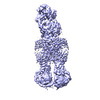
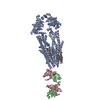
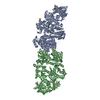

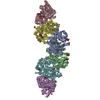
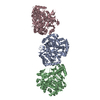

 Z (Sec.)
Z (Sec.) Y (Row.)
Y (Row.) X (Col.)
X (Col.)





















